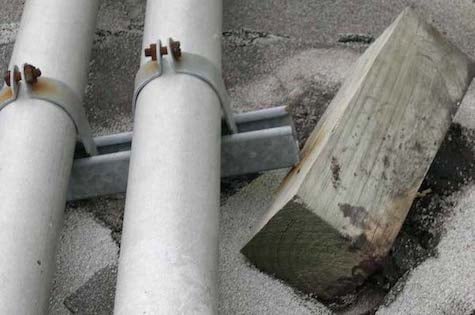 If you do business out of a building that is relatively old, it likely has wooden supports to hold up pipes and equipment on the roof. This approach to commercial and industrial rooftops deserves some fresh thinking, since better solutions are now available.
If you do business out of a building that is relatively old, it likely has wooden supports to hold up pipes and equipment on the roof. This approach to commercial and industrial rooftops deserves some fresh thinking, since better solutions are now available.
Builders have been using wooden pipe and equipment supports for decades. During the earliest phases of the modern construction era, wood blocks were state of the art, since they provide a high load tolerance. Wood is easily obtainable and relatively inexpensive, making it attractive to roofing specialists of the past. In fact, for a long time, wood was the only option.
However, that’s no longer the case. Wooden rooftop supports being used today have many drawbacks, which is why you’ll want to consider superior, modern options now available to use at your facility.
They Deteriorate
Wood is subject to damage that the original installers may not have taken into account. Powerful winds, rain, and snowstorms assault the roof on a regular basis, not to mention constant temperature fluctuations taking a toll.
When the wood eventually deteriorates to the breaking point, the loss of support can send pipes and equipment crashing into a roof’s protective membrane. You’ll want to protect your roof from such problems at all costs to avoid financial losses from costly repair jobs.
They Can Damage Rooftops
Pipes expand and contract on the roof every day because of shifting temperatures. These fluctuations cause the wooden blocks to move. When wooden blocks used for rooftop supports move freely like this, their rough surfaces will scrape and erode the roof’s membrane. Over time the sharp corners of the wood will actually dig into the membrane causing a costly repair job.
Further, wooden supports are much easier to inadvertently overload. Since wood cannot provide even load distribution, relatively small areas of contact can lead to, what industry professionals refer to as, “point loading damage.” Tearing of the membrane and insulation due to the pressure of wooden blocks digging in.
They Cost More in the Long Run
To achieve the lowest possible total cost of ownership of your roof, your organization will be better off using a modern, pre-built solution instead of old-fashioned wood. While the up front cost might be higher, avoiding potential repairs in the future from rips and tears in the roof membrane or broken pipes more than offset the cost difference.
There Are Better Options Now
After learning about the major problems involved with wooden rooftop pipe and equipment supports, you and your fellow stakeholders should explore the better alternatives now available.
Pre-manufactured assemblies of the non-penetrating type are now available and come in a variety of styles. For optimal performance, look for a supplier that can offer you a customized roof support system built with materials that can hold up to the demanding environments of commercial rooftops. Options like our very own high-density polypropylene bases with UV additives to protect against the harsh sun and hot-dipped galvanized steel support structures.
No matter what you choose, we recommend consulting with roofing professionals to determine the best approach for your particular building when it comes to your rooftop pipe and equipment support options.





